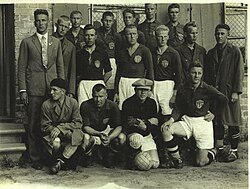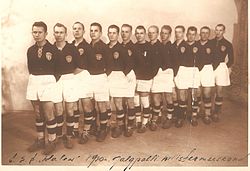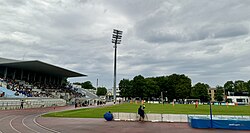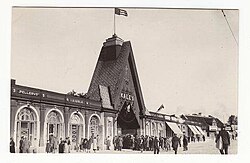JK Tallinna Kalev
 From Wikipedia - Reading time: 13 min
From Wikipedia - Reading time: 13 min
 | |||
| Full name | Jalgpalliklubi Tallinna Kalev | ||
|---|---|---|---|
| Founded | 1909 (as Meteor) 25 May 1911 (as Kalev) Re-established on 1 September 2002[1] | ||
| Ground | Kadriorg Stadium | ||
| Capacity | 5,000[2] | ||
| President | Ragnar Klavan | ||
| Manager | Teemu Tainio | ||
| League | Meistriliiga | ||
| 2024 | Meistriliiga, 9th of 10 | ||
| Website | https://jkkalev.ee | ||
|
| |||
Jalgpalliklubi Tallinna Kalev, also known as Tallinna Kalev or simply Kalev, is an Estonian professional football club based in Tallinn that competes in the Meistriliiga, the top flight of Estonian football. Founded in 1911, it is the oldest active football club in the country. The club's home ground is the Kadriorg Stadium.
Formed as Meteor in 1909, the club changed its name to Kalev in 1911 after joining the Estonian Sports Association Kalev. The club were founding members of the Estonian Football Championship in 1921. Kalev have won two Estonian championship titles, in 1923 and 1930, and one Estonian SSR championship in 1955. The club was re-established in 2002 and has played in the Meistriliiga in 2007–2009, 2012–2014, 2018–2020 and again since 2022.
History
[edit]Early years
[edit]Kalev's origins lie with Meteor. Jalgpalliselts Meteor (Football Association Meteor) was formed in 1909 by students Julius Reinans and Bernhard Abrams. The team was first coached by a Scottish flax merchant John Stormonth Urquhart who also ordered the team's first uniforms, consisting of blue shirts and white shorts. The team included several players who would become notable athletes, such as future Estonia national team players Voldemar Luik and Otto Silber and Olympic runner Johannes Villemson. On 6 June 1909, Meteor and Merkuur played the first official football match in Estonia. The match took place at the grounds behind the Lower Lighthouse in Lasnamäe and was won by Meteor 4–2.[3]
On 27 May 1911, Meteor joined the Estonian Sports Association Kalev and changed its name to Kalev. In 1913, the team moved to the new Tiigiveski Ground.[1]
Estonian champions
[edit]
In the 1920s, the newly formed Estonian Football Championship was dominated by Tallinn sides Kalev, Sport and TJK. The derby matches between the clubs drew thousands of spectators. Kalev won their first league title in 1923. The team included Estonian internationals such as Eduard Ellmann, Ernst Joll, Elmar Kaljot, August Lass and Arnold Pihlak, who went on to represent Estonia at the 1924 Summer Olympics. On 16 August 1925, the team suffered a serious setback when the board of the association expelled eight key players from the squad over their decision to play in the opening match of TJK's new ground without the board's permission. The players subsequently joined TJK.[4]

Tallinna Kalev won their second championship in the controversial 1930 season. Although never proven officially, the victory was widely accepted as a result of match fixing. To win the title, Kalev needed to win the final game of the season against the formidable Narva Võitleja by eight goals and went on to win the match 11–0. Võitleja's performance was so poor that allegations of match fixing began instantly, with Kalev board member Aleksander Mändvere being accused of bribing Võitleja players, particularly the team's goalkeeper Viruvere.[4]
Kalev reached the 1939 Estonian Cup final, but lost to TJK 1–4.[1]

Kalev in Soviet football
[edit]
Following World War II and the Soviet occupation of Estonia, Kalev joined the Soviet Union football league system, competing in the second tier of Soviet football from 1947 to 1954, while Kalev's second team played in the local Estonian SSR championship. In 1955, Kalev's first team returned to the local championship, winning their third league title.
In 1960, Kalev joined Class A, the top flight of Soviet football. The team finished their first season in Class A in 19th place out of 22 teams. The home match against Dynamo Moscow in Kalev's Komsomol Stadium brought a record 20,000 people onto the stands, as a number of Dynamo's players along with the famed Lev Yashin had been crowned European champions less than a month before. In the 1961 season, Kalev finished last and were relegated to Class B.[1] Despite the relegation, Kalev showed several great performances during the season, drawing 2–2 with bronze medalists Spartak Moscow and 0–0 with Dynamo Moscow.
Re-establishment
[edit]
Tallinna Kalev was re-established on 1 September 2002 and joined the Estonian football league system. The club won the Northern division of the III liiga in 2003. In 2004, Aavo Sarap was appointed as manager and Tallinna Kalev won the East/North division of the II liiga. The club finished the 2006 Esiliiga in third place and were promoted to the Meistriliiga, returning to the top flight of Estonian football. Tallinna Kalev finished the 2007 season in sixth place. In August 2009, Sarap's contract was terminated and he was replaced by his assistant Daniel Meijel. The team finished the 2009 season in last place and were relegated.
In January 2010, Sergei Ratnikov was appointed as manager. Tallinna Kalev won the 2011 Esiliiga were promoted back to the Meistriliiga. The club finished the 2012 season in ninth place, but avoided being relegated by defeating Tarvas 3–1 on aggregate in the relegation play-offs. In December 2012, Frank Bernhardt was appointed as manager. Tallinna Kalev finished the 2013 season in eighth place. In January 2014, former Estonia national team manager Tarmo Rüütli took over as manager. Rüütli subsequently left in March 2014 and Sergei Zamogilnõi took over as manager. Following a disappointing 2014 season, where Tallinna Kalev finished in 10th place and were relegated to the Esiliiga once again, Zamogilnõi was replaced by Marko Pärnpuu.
In May 2016, it was announced that Ragnar Klavan would become the club's president. Former New York Red Bulls player Joel Lindpere took over the sporting director role. Tallinna Kalev returned to the Meistriliiga after finishing the 2017 Esiliiga season as runners-up. In November 2017, Pärnpuu was replaced by Argo Arbeiter. The team finished the 2018 season in eighth place, after which Arbeiter left and Aleksandr Dmitrijev took over as manager and also led Kalev to an eighth-place finish in the 2019 season. Kalev was relegated from Meistriliiga in 2020, after finishing the season in last place, but returned to top-flight football in 2022. Led by Daniel Meijel and Aivar Anniste, the club finished the 2022 season in eighth place.
Qualification to Europe
[edit]
2023 was a groundbreaking year for Kalev in many ways. The club constructed an indoor football dome in Mustamäe and became the first football club in the country to open a specialised football academy.[5] The summer transfer window saw club's president Ragnar Klavan join the first team as a player. Kalev also acquired Finnish goalkeeper Oskari Forsman, who was named in the Team of the Year after the season,[6] and also named The Best Goalkeeper and The Best Transfer of the Season.[7] Tallinna Kalev finished the 2023 season in 3rd place, earning their first bronze medals since the 1937–38 season and qualifying to UEFA Conference League, the first European campaign in the club's entire history. Kalev made their debut in Europe on 11 July 2024, losing 1–2 to Urartu in the home leg of the Conference League first qualifying round. In August 2024, Kalev appointed Teemu Tainio as head coach. The club finished the 2024 season in ninth place, but avoided relegation by defeating Viimsi 2–1 on aggregate in the play-offs.
Crest and colours
[edit]Kalev's original crest was created during the Estonian national awakening period and adopted the Estonian flag's blue-black-white tricolour, which remains as the prominent part of the crest to this day. The first crest also featured 12 stars, of which eleven symbolised each of the eleven counties of Estonia, and the twelfth star was a symbol for the Estonians who were forced to spend their life abroad and away from their homeland.[8] After the country was occupied by the Soviet Union in 1940, all symbols relating to Estonian nationalism were banned. The current crest was created in 1988 in the wake of the Singing Revolution and saw the stars of the original crest replaced by the letters "KALEV".[9]
-
Former crest (1911–1940)
-
Crest in use since 2002
Kalev traditionally played in black shirts and white shorts during the first period of independence of Estonia. After the club was re-established in 2002, Kalev began playing in white shirts before adopting the Estonian tricolour as their home colours in 2019, after which they played in blue shirts, black shorts and white socks until 2022. In 2023, Kalev returned to their original black coloured home shirts.
Kit manufacturers and shirt sponsors
[edit]| Period | Kit manufacturer | Shirt sponsor | Ref |
|---|---|---|---|
| 2008–2011 | Nike | Unicef | [10] |
| 2012–2014 | Jako | — | |
| 2015–2017 | Nike | ||
| 2018–2019 | Coolbet | ||
| 2020–2022 | Macron | ||
| 2023– | Unibet |
Stadium
[edit]
Kalev first started playing its home matches at the Tiigiveski Ground, before the club opened Kalevi Aed in the Tallinn city centre in 1923. Kalevi Aed was destroyed after World War II, in the 1940s.
The club's traditional home ground is the 12,000-seat Kalevi Keskstaadion.[11] Opened on 12 July 1955, the multi-purpose stadium was built near Kalev's old Tiigiveski Ground. Initially named Kalev Komsomol Stadium, the name was changed to Kalevi Keskstaadion in 1989. It used to be the largest football stadium in Estonia until the expansion of A. Le Coq Arena in 2018.

From the 2020 season the team moved to Kadriorg Stadium, as Kalevi Keskstaadion underwent renovation due to its poor condition.[12] Although the renovation works were completed in 2022, the football club has not returned to the 12,000-capacity stadium due to a dispute with the owner of the stadium complex, the Estonian Sports Association Kalev, which has evolved into a court case.[13]
Tallinna Kalev uses the 1,198-seat artificial turf ground Sportland Arena for home matches during winter and early spring months. In 2024, the club opened an indoor football facility named Raja Jalgpallihall that serves as the club's primary training base.
Players
[edit]Current squad
[edit]Note: Flags indicate national team as defined under FIFA eligibility rules; some limited exceptions apply. Players may hold more than one non-FIFA nationality.
|
|
Reserves and academy
[edit]Personnel
[edit]
Current technical staff[edit]
|
Managerial history[edit]
| ||||||||||||||||||||||||||||||||||||||||||||||||||||
Honours
[edit]League
[edit]- A klass/Liiduklass
- Esigrupp (Estonian SSR Championship)
- Winners (1): 1955
- Esiliiga
- Winners (1): 2011
Cup
[edit]- Estonian Cup
- Runners-up (1): 1939
Seasons and statistics
[edit]Seasons
[edit]| Season | Division | Pos | Pld | W | D | L | GF | GA | GD | Pts | Top goalscorer | Cup |
|---|---|---|---|---|---|---|---|---|---|---|---|---|
| 1921 | Meistriliiga | 3-4 | Lost the semi-final replay 0–3 vs Sport | |||||||||
| 1922 | 2 | Lost the final 2–4 vs Sport | ||||||||||
| 1923 | 1 | Won the final 6–0 vs Tartu ASK | ||||||||||
| 1924 | 2 | Lost in a 4-match final vs Sport | ||||||||||
| 1925 | 2 | Lost the final 0–3 vs Sport | ||||||||||
| 1926 | 3-4 | Lost the semi-final 0–6 vs TJK | ||||||||||
| 1927 | 3-4 | Lost the semi-final 1–4 vs TJK | ||||||||||
| 1928 | did not take part due to a conflict with the Estonian FA | |||||||||||
| 1929 | 3 | 5 | 2 | 1 | 2 | 9 | 9 | 0 | 5 | |||
| 1930 | 1 | 3 | 2 | 1 | 0 | 13 | 1 | +12 | 5 | |||
| 1931 | 2 | 5 | 3 | 1 | 1 | 9 | 2 | +7 | 7 | |||
| 1932 | 3 | 10 | 5 | 1 | 4 | 16 | 15 | +1 | 11 | |||
| 1933 | 4 | 10 | 4 | 0 | 6 | 15 | 30 | −15 | 8 | |||
| 1934 | 5 | 10 | 1 | 1 | 8 | 9 | 35 | −26 | 4 | |||
| 1935 | 5 | 7 | 2 | 2 | 3 | 16 | 13 | +3 | 6 | |||
| 1936 | 5 | 14 | 7 | 0 | 7 | 28 | 27 | +1 | 14 | |||
| 1937−38 | 3 | 14 | 8 | 2 | 4 | 43 | 26 | +17 | 18 | |||
| 1938−39 | 5 | 14 | 5 | 4 | 5 | 27 | 23 | +4 | 14 | Quarter-finals | ||
| 1939−40 | 5 | 14 | 5 | 4 | 5 | 18 | 21 | −3 | 14 | Runners-up | ||
| Estonia was occupied by Soviet Union in 1940, JK Tallinna Kalev was re-established in 2002 | ||||||||||||
| 2003 | III liiga (N) | 1 | 18 | 14 | 3 | 1 | 56 | 11 | +45 | 45 | ||
| 2004 | II liiga (N/E) | 1 | 28 | 22 | 3 | 3 | 90 | 32 | +58 | 69 | ||
| 2005 | Esiliiga | 4 | 36 | 18 | 9 | 9 | 85 | 71 | +14 | 63 | Second round | |
| 2006 | 3 | 36 | 20 | 6 | 10 | 84 | 63 | +21 | 66 | Quarter-finals | ||
| 2007 | Meistriliiga | 6 | 36 | 13 | 4 | 19 | 44 | 74 | −30 | 43 | First round | |
| 2008 | 8 | 36 | 6 | 8 | 22 | 37 | 70 | −33 | 26 | Quarter-finals | ||
| 2009 | 10 | 36 | 4 | 4 | 28 | 32 | 89 | −57 | 16 | Fourth round | ||
| 2010 | Esiliiga | 5 | 36 | 17 | 6 | 13 | 67 | 65 | +2 | 53 | Fourth round | |
| 2011 | 1 | 36 | 21 | 10 | 5 | 102 | 39 | +63 | 73 | Quarter-finals | ||
| 2012 | Meistriliiga | 9 | 36 | 4 | 9 | 23 | 27 | 87 | −60 | 21 | Fourth round | |
| 2013 | 8 | 36 | 10 | 4 | 22 | 35 | 77 | −42 | 34 | Second round | ||
| 2014 | 10 | 36 | 3 | 3 | 30 | 21 | 146 | −125 | 12 | Second round | ||
| 2015 | Esiliiga | 5 | 36 | 13 | 7 | 16 | 47 | 59 | −12 | 46 | Second round | |
| 2016 | 7 | 36 | 13 | 6 | 17 | 56 | 58 | −2 | 45 | First round | ||
| 2017 | 2 | 36 | 24 | 2 | 10 | 95 | 44 | +51 | 74 | Quarter-finals | ||
| 2018 | Meistriliiga | 8 | 36 | 7 | 7 | 22 | 54 | 68 | −14 | 28 | Second round | |
| 2019 | 8 | 36 | 6 | 6 | 24 | 29 | 89 | −60 | 24 | Fourth round | ||
| 2020 | 10 | 30 | 5 | 5 | 20 | 20 | 68 | −48 | 20 | Semi-finals | ||
| 2021 | Esiliiga | 2 | 30 | 21 | 8 | 1 | 78 | 32 | +46 | 71 | Quarter-finals | |
| 2022 | Meistriliiga | 8 | 36 | 10 | 5 | 21 | 42 | 92 | −50 | 35 | Fourth round | |
| 2023 | 3 | 36 | 14 | 11 | 11 | 49 | 41 | +8 | 53 | Fourth round | ||
| 2024 | 9 | 36 | 8 | 7 | 21 | 37 | 74 | -37 | 31 | Quarter-finals | ||
Europe
[edit]| Season | Competition | Round | Opponent | Home | Away | Agg. |
|---|---|---|---|---|---|---|
| 2024–25 | UEFA Conference League | First qualifying round | 1–2 | 0–2 | 1–4 |
References
[edit]- ^ a b c d "History". Tallinna Kalev.
- ^ "Kadrioru Staadion". spordiregister.ee (in Estonian).
- ^ Malkin, Mikhail (22 June 2009). "Estonia toasting 100 years of football". UEFA.
- ^ a b "Top 10 - meistriliiga šokeerivaimad juhtumid 1921-1940" (in Estonian). Soccernet.ee. 3 February 2016.
- ^ "Video: JK Tallinna Kalev loob mitmekülgset noorteakadeemiat". sport.tv3.ee (in Estonian). 31 October 2023.
- ^ Kellest said parimad ja halvimad? Fännide valitud hooaja sümboolsesse koosseisu mahub vaid kaks meistrit (kes arenes enim, kes on aasta treener?, soccernet.ee, 29 November 2023
- ^ Premium liiga parimad ründajad ja väravavahid 2023, soccernet.ee, 8 November 2023
- ^ "Eesti Spordiselts KALEV". Eesti Spordileht. 29 May 1931. p. 3.
- ^ "«Kalevi» sümboolika – rinnamärk, embleem ja lipp – kinnitatud". Spordileht. 10 October 1988.
- ^ "JK Tallinna Kalev Kit History". Football Kit Archive. Retrieved 2024-08-05.
- ^ "Kalevi Keskstaadion" (in Estonian). Estonian Football Association.
- ^ "Kalev kolib uueks hooajaks kodumängud Kadriorgu". soccernet.ee. 15 December 2019.
- ^ Järvela, Ott (2023-02-22). "Kus on Kalevi kodu? Ehitusluba oodatakse, kohtus vaieldakse, Kadriorus ja Lillekülas mängitakse". Soccernet.ee.
- ^ "JK Tallinna Kalev". Estonian Football Association. Retrieved 8 March 2020.
- ^ "Esindusmeeskond". JK Tallinna Kalev.
External links
[edit]- Official website (in English and Estonian)
- JK Tallinna Kalev at Estonian Football Association
 KSF
KSF
